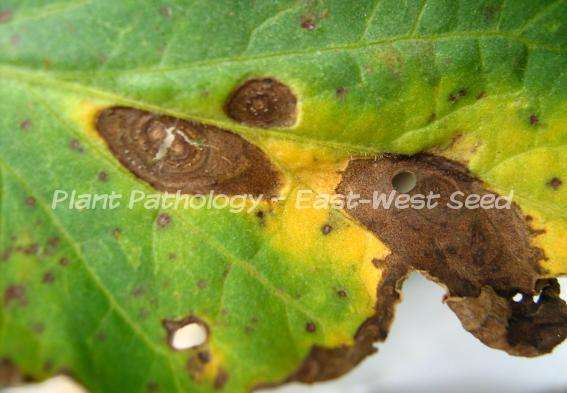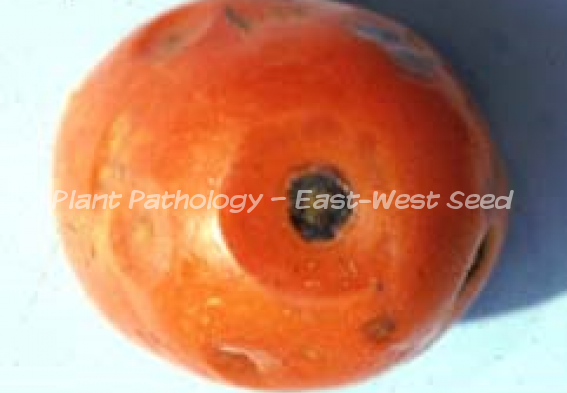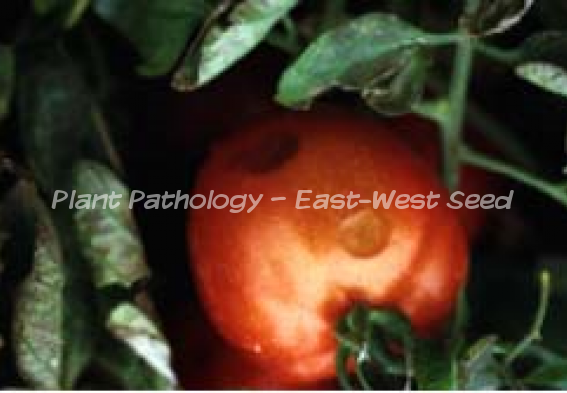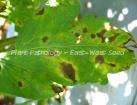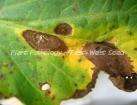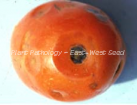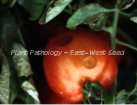Causal Agent:
Fungus (Colletotrichum spp.)
| Characteristic Symptoms: | |
 |
Affects both foliage and fruits but is less common in tomato fruit. |
 |
Affected tomato leaves have yellowish, brownish or dark gray necrotic spots with dark brown edges and concentric rings. |
 |
Fruits may be infected at the early stage but symptoms are expressed at maturity when conditions are favorable for infection |
| Conditions for Disease Development: | |
 |
The fungus is soil-borne and overwinters on plant debris.
|
 |
The pathogen has a broad host range.
|
 |
Spores produced on foliage can be carried through rain splashes to the developing green fruit.
|
 |
Although symptoms do not appear until the fruit is ripening, the infection actually occurs when fruits are small and green.
|
 |
The fungus is activated by exposure of the fruit to low temperatures, fruit maturation or plant stress.
|
 |
The disease is favoured by warm temperature and frequent rainfall.
|
| Management and Control: | |
 |
Remove and dispose infected plants/fruits as soon as symptoms are observed to minimize spread of disease.
|
 |
Avoid overhead irrigation or prolonged moisture to minimize disease incidence and severity.
|
 |
Staking increases air movement and may help reduce infection in the field.
|
 |
Remove weeds that may serve as alternate hosts of the fungus.
|
 |
Crop rotation for 2-3 years may help reduce inoculum in the soil.
|
 |
Use pathogen-free seed.
|
 |
Apply copper-based fungicides (e.g. Cupravit®, Super BlueⓇ, Vitigran blueⓇ, FunguranⓇ, KocideⓇ, Hydroxide superⓇ) at early fruit set when conditions are favorable. Application of other fungicides like difenoconazole (e.g. ScoreⓇ, MontanaⓇ, PursueⓇ, BashⓇ), difenoconazole+proficonazole (e.g. ArmureⓇ), Pyraclostrobin (e.g. Cabrio 25 ECⓇ), Bacillus subtilis strain QST 713 (e.g. Serenade®, Virtuoso®) and azoxystrobin (Amistar®, MiradorⓇ, RobatoⓇ). |
 |
Harvest fruit before it fully ripens.
|
 |
Application of other fungicides like difenoconazole (e.g. ScoreⓇ, MontanaⓇ, PursueⓇ, BashⓇ), difenoconazole+proficonazole (e.g. ArmureⓇ), Pyraclostrobin (e.g. Cabrio 25 ECⓇ), Bacillus subtilis strain QST 713 (e.g. Serenade®, Virtuoso®) and azoxystrobin (Amistar®, MiradorⓇ, RobatoⓇ). |
| References: | |
| Tomato Anthracnose (http://www.extension.umn.edu/yardandgarden/ygbriefs/p250tomatoanthracnos... http://ohioline.osu.edu/hyg-fact/3000/3114.html; http://www.plantpath.ksu.edu/doc761.ashx) | |
To view other diseases, click here.
Need more help? Ask the Doctor.




